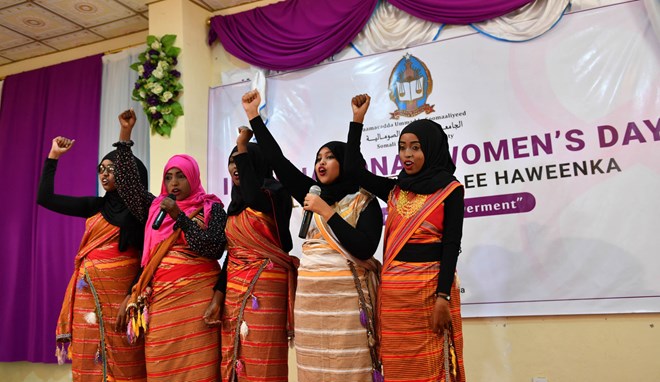International Women’s Day marked with increased hardships for women




Source: Monday March 8, 2021
Photo/ UNSOM
For more than 100 years, International Women’s Day has been celebrated by honoring the achievements of women globally.
But this year, because of lost jobs and increased burdens of care at home, women have fared worse economically than men.
According to data from the International Labour Organization, a United Nations agency, globally women have suffered more job losses related to the pandemic than men. About 5% of women in 2020 lost work, which could mean losing a job or experiencing reduced hours, compared with 3.9% of men.
“Every time something happens in the world, women are hit with twice the violence,” Anchia Mulima, coordinator of Lemusica, an organization supporting women and girls in Mozambique, told VOA. Throughout the pandemic, the United Nations has highlighted the disparities between how women have been affected by the crisis compared with men.
“Gender inequalities have increased dramatically in the past year, as women bear the brunt of school closures and working from home,” U.N. Secretary-General Antonio Guterres said.
According to U.N. Women, 58% of employed women globally work in “informal employment,” or jobs without much regulation and often without taxes or benefits. Women are also more likely to work in industries hardest hit by the pandemic, such as hospitality and child care.
In the United States, Black and Latinx women faced more layoffs in 2020 and have seen slower gains in recent months than their white counterparts.
According to data from the U.S. Bureau of Labor Statistics (BLS), 8.9% of Black women and 8.5% of Latinx women were unemployed in February — compared with 5.2% of white women.
“It’s easy for us to make general sweeping statements of COVID-19 is affecting women in the workplace, but it’s affecting different groups of women disproportionately,” Minda Harts, an author and advocate for Black women in the workplace, told VOA.
“Hospitality, leisure — some of those industries have a very high concentration of Black and brown women. And so in 2020, we realized that a lot of those industries were heavily affected,” Harts said.
Even as women around the world have faced economic challenges, higher unemployment, and the burden of child care as schools close, they have found ways to use their skills and inspire others.
Nubia Rocío Gaona Cárdenas, a farmer in Colombia, said it broke her heart to see mothers struggling to feed their children in the capital of Bogota. She and her son had an idea.
“My son told me, ‘Mom, let’s do something productive. Some YouTube channels … don’t teach anything, let’s teach them how to farm, or teach them something. Let’s give them hope,’” Cárdenas told VOA.
Their channel on YouTube, which they launched in April 2020, now has more than 700,000 followers.
Across the globe, women working as tailors and seamstresses answered the surge in demand for face masks to curb the spread of the coronavirus.
“We believe that women are strong and can make a change. We too have abilities and can work alongside men,” Niga Mohammed, an Iraqi tailor, told VOA.
With so much work shifted to remote employees, Harts sees an opportunity for industries to diversify their workforce.
“I do believe there will be a lot more opportunities for Black and brown women to work at the high-tech companies, to work at the Fortune 500 companies from rural places that they might live, or from certain areas where they just don’t have the capacity to up and move to a big city,” she said.
But as numbers from the BLS indicate from the past few months, those changes may be slow to arrive.
This year, the theme of International Women’s Day is “Choose to Challenge.”
“A challenged world is an alert world. And from challenge comes change,” according to the International Women’s Day website.
For many women around the world amid the pandemic, the immediate challenge may be staying afloat economically.

